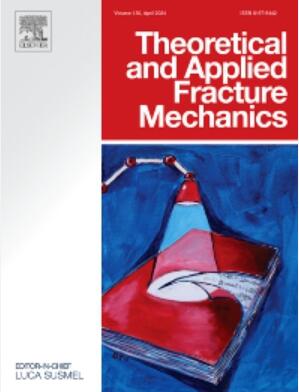Investigating the impact of thermal treatment on fracture toughness and sub-critical crack growth parameters under mode II loading
IF 5.6
2区 工程技术
Q1 ENGINEERING, MECHANICAL
引用次数: 0
Abstract
Studying subcritical crack growth is crucial to investigating the long-term behavior of rocks under applied loads and evaluating the long-term stability of underground and surface structures in rock masses. While considerable research has been done to determine subcritical crack growth parameters in mode I, Studies on subcritical crack growth under mode II loading are limited despite its important applications in rock engineering problems. The purpose of the study is to understand the thermal effect on the fracture behavior of hornfels rock, which were heated at 25 °C (without thermal treatment), 250 °C, 500 °C, and 750 °C, respectively. The subcritical crack growth parameters were determined using the constant stress rate test and one of the available fracture mechanics tests for mode II loading, namely, the four-point bending test. Experiments were conducted at three fixed displacement rates of 0.06 mm/min, 0.6 mm/min, and 6 mm/min, and three experiments were performed in each case to ensure repeatability. The results showed that the fracture toughness of hornfels samples increased with increasing temperature up to 250 °C and then decreased with increasing heat treatment temperature. The fracture toughness decreased drastically due to the thermal breakdown of the quartz crystal structure and the creation of wider intergranular fractures. The study indicated that for the hornfels samples, the subcritical parameter A decreased and beyond this temperature, parameter A began to increase while parameter n remained relatively constant as the temperature rose to 750 °C. The subcritical crack growth rate was calculated using the subcritical crack growth parameters and the stress intensity factor under mode II loading. For a certain value of the stress intensity factor KII, the highest subcritical crack velocity occurred at the temperature of 750 °C (5.76×10−7–2.47×10−1 m/s), and the lowest velocity of the subcritical crack occurred at the temperature of 250 °C (3.30×10−11–6.84×10−5 m/s). The impact of inert strength, calculated at the highest loading rate, on subcritical parameters across various temperatures was examined. The findings indicate that the subcritical crack growth parameter A is reliant on inert strength.
研究热处理对模式 II 加载下断裂韧性和亚临界裂纹生长参数的影响
研究次临界裂纹生长对于研究岩石在外加荷载作用下的长期行为以及评估岩体中地下和地表结构的长期稳定性至关重要。虽然在确定模式 I 下亚临界裂纹生长参数方面已经做了大量研究,但对模式 II 载荷下亚临界裂纹生长的研究却很有限,尽管它在岩石工程问题中有着重要应用。本研究的目的是了解热效应对角砾岩断裂行为的影响,角砾岩分别在 25 ℃(未经热处理)、250 ℃、500 ℃ 和 750 ℃ 下加热。亚临界裂纹生长参数是通过恒定应力速率试验和模式 II 加载的现有断裂力学试验之一(即四点弯曲试验)确定的。实验以 0.06 毫米/分钟、0.6 毫米/分钟和 6 毫米/分钟三种固定位移速率进行,每种情况下进行三次实验,以确保重复性。结果表明,角闪石样品的断裂韧性在 250 ℃ 以下随温度升高而增加,然后随热处理温度升高而降低。断裂韧性急剧下降的原因是石英晶体结构受热破坏,产生了更宽的晶间裂缝。研究表明,对于角闪石样品,亚临界参数 A 有所下降,超过这一温度后,参数 A 开始增加,而参数 n 在温度升至 750 ℃ 时保持相对恒定。利用次临界裂纹生长参数和模式 II 载荷下的应力强度因子计算出了次临界裂纹生长率。在应力强度因子 KII 取一定值的情况下,温度为 750 ℃ 时亚临界裂纹速度最大(5.76×10-7-2.47×10-1 m/s),温度为 250 ℃ 时亚临界裂纹速度最小(3.30×10-11-6.84×10-5 m/s)。研究了以最高加载速率计算的惰性强度对不同温度下亚临界参数的影响。研究结果表明,次临界裂纹增长参数 A 依赖于惰性强度。
本文章由计算机程序翻译,如有差异,请以英文原文为准。
求助全文
约1分钟内获得全文
求助全文
来源期刊

Theoretical and Applied Fracture Mechanics
工程技术-工程:机械
CiteScore
8.40
自引率
18.90%
发文量
435
审稿时长
37 days
期刊介绍:
Theoretical and Applied Fracture Mechanics'' aims & scopes have been re-designed to cover both the theoretical, applied, and numerical aspects associated with those cracking related phenomena taking place, at a micro-, meso-, and macroscopic level, in materials/components/structures of any kind.
The journal aims to cover the cracking/mechanical behaviour of materials/components/structures in those situations involving both time-independent and time-dependent system of external forces/moments (such as, for instance, quasi-static, impulsive, impact, blasting, creep, contact, and fatigue loading). Since, under the above circumstances, the mechanical behaviour of cracked materials/components/structures is also affected by the environmental conditions, the journal would consider also those theoretical/experimental research works investigating the effect of external variables such as, for instance, the effect of corrosive environments as well as of high/low-temperature.
 求助内容:
求助内容: 应助结果提醒方式:
应助结果提醒方式:


